| Article ID | Journal | Published Year | Pages | File Type |
|---|---|---|---|---|
| 2425379 | Aquaculture | 2007 | 9 Pages |
The influence of differing self-feeding regimes on growth, behaviour, food wastage and injury was studied in group-held (n = 10 group− 1) rainbow trout, Oncorhynchus mykiss. Triplicate groups of trout received a single 3-h meal at dawn. A further three groups received 3 × 2-h meals at dawn, midday and dusk, and three further groups received unrestricted 12-h light-phase access to self-feeders. Trigger actuations during meals under the 1-meal and 3-meal regimes accounted for 68.8% and 75.7% of the total number of daily actuations, respectively. The findings from this study demonstrate no significant differences in ration size, growth rate (SGR), condition factor (K), size heterogeneity, food wastage and feed conversion ratio (FCR) between feed regimes. Levels of aggression during both feeding and non-feeding periods were highest in the 1-meal regime. In addition, feed regime had no significant effect on the incidence of fin splitting or fin erosion to the caudal upper, caudal lower or dorsal fins, and the incidence of fin splitting did not change over time, irrespective of feed regime. Interestingly, the 1-meal regime significantly hindered recovery from dorsal fin erosion, whilst caudal fin erosion (to the upper caudal lobe) significantly increased with time in the 1-meal and free access regime.
